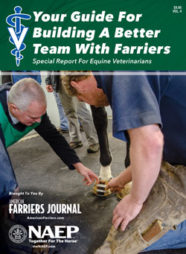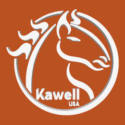Each year, we ask farriers via an exclusive survey to comment on ethical dilemmas that they might face in their hoof-care work. These scenarios were pulled from dozens of responses submitted by farriers in the previous year’s confidential ethics survey.
In this survey, hoof-care professionals shared how they would deal with each of these entirely different ethical situations.
Each of these ethical dilemmas are described in detail here along with a summary on how these farriers indicated they would deal with these troublesome situations. As you will see from the survey results, there are no easy answers for or 100% agreement on these three ethical predicaments.
Looking through each scenario, how would you have voted on these situations?
#1 Ethical Dilemmas At Work
In your daily life, there are times when you are presented with dilemmas that you must answer by the personal code of ethics that guides you. In your farrier practice, you may encounter tough situations with clients and horses that you must resolve by applying your own personal code of ethics? Two examples include being asked to work with an unruly horse by yourself or being asked to trim/shoe a show horse in a way the trainer would like, but isn’t good for the horse. How often do ethical dilemmas happen to you in your practice?

Advice From Farriers
- If what is being asked of me is not good for the horse, then I will not work on the horse. The horse is what matters the most — the horse is the actual client.
- When I have been told how to shoe by a trainer, I simply replied to them I shoe the way I shoe and if they don’t like the way I shoe, they could get someone else. They never did.
- The skill of a good horseman is lost. If it doesn’t work, it’s always the shoer’s fault in the minds of many owners. So I will not do anything unless I believe in it. If it goes good or bad, it is on me.
- I’m learning to be firm in my reasoning and methods unless actual facts change the situation.
- I think it’s important to make sure you work for people that care about your safety. When it comes to working with trainers, it’s our job to let them know we hear their input. Most of the time, I find even if you don’t do what they want, you can keep them happy by not being confrontational.
.
#2 An Inexperienced Veterinarian Gives Unsolicited Opinion
You have a client who is good about keeping her horse on an 8-week schedule. She is a good client who is nearby and pays on time for a trim and four shoes.
You show up for an appointment at 10 weeks — the client had to delay due to a family vacation. The day before, a veterinarian came to vaccinate the horse. This vet is about 6 months out of school and just joined a small and large animal practice. You have a good working relationship with the other members of the practice, but have never interacted with this vet.
While holding the horse during your work, the client says the young vet left a message for you as the farrier to take more off the toes — they look long. At first, the client seems to take the vet at her word and questions why you didn’t take more off last time, but after you explain growth and the lateness of the shoeing cycle, the novice owner thanks you for the lesson.
What would likely be your next step?

Advice From Farriers
- Stay calm and discuss it, if possible, with the vet.
- If she doesn’t seem to understand, then I would call the owner of the practice only to inform him/her of what went on.
- The client needed to speak up and say the horse is 2 weeks overdue on an 8-week cycle.
- The farrier should have explained this long before this situation occurred, at least when the schedule was made for 10 weeks. Then the owner would have replied to the vet in a different manner to let them know they are over their due date.
- If the problem continues, I would talk to one of the other vets in the practice.
- I have actually had this happen with not only young vets, but experienced vets who have re-located to my area. I immediately called them and asked to meet with them to discuss what they had seen so we could be “on the same page” with the client and horse.
- In my practice, it is not only young inexperienced vets who do this. Even the seasoned vets with 20-plus years still do it. Unfortunately, they seldom ask the owner when the horse was last done and the owners don’t tell them or don’t even keep a record of when their horse was done. So basically, the trimming/shoeing schedule is never taken into consideration.
- I find this is often a miscommunication between vet and owner. If I call the vet, they think I’m being critical of their well-
intentioned advice. - After explaining to the client that the toes are long because of the extended shoeing cycle, I would offer to call the vet to clear things up. I don’t like to miss an opportunity to build a relationship with a vet regardless of their experience. I never know when I might have to work with that vet in the future, so I like to start off on the right foot. This also helps to reassure the client that their horse’s care is my number one priority.
- Beating your head on a wall will just give you a headache.
- I do not work on hooves longer than 5 to 6 weeks as it is in the best interest of the hooves/horse, which is supported by recent research.
- Pick and choose your battles. Some things don’t warrant a response. Everyone is entitled to an opinion and the vet is voicing their thoughts. This doesn’t ruffle my feathers or alter my plans to any greater extent than a clerk at Tractor Supply offering his or her opinions. I just smile and nod unless asked for my opinion. Saying “OK” doesn’t mean I agree, it just means I am acknowledging that I heard words coming out of your mouth, but not anything that sounded like a question.
- Most of the time this is results from a lack of education.
.
#3 Owner Isn’t Helping The Horse
You get a call from a potential client who has three horses to trim and doesn’t question your rate. You don’t know this farm, and none of your farrier friends recognize it. You show up to trim the horses and see three obese horses in the pasture. Before the owner fetches the first horse, you ask about the horses’ feed. Besides the pasture grass, hay and grain, the owner notes she also likes to give the horses bread as a treat.
You politely tell her that the horses are unhealthy and overweight. You give a quick explanation of how this negatively affects the hoof and overall horse health. The owner says she knows they are obese, but she can’t help herself — she says the trio are her “babies” and loves to spoil them.
What do you do?

Advice From Farriers
- I would trim the horses, but explain to her that she is not showing love to her horses. Instead, she is being abusive.
- Remember what your job is: trim/shoe and to educate, not be judgmental or an enforcer.
- Ask who her vet is and bring the issue to that practitioner’s attention
- If clients do not follow our advice it is a losing battle — we cannot help the horse in these situations.
- As long as the horses were behaved, I would continue to keep them on a schedule. Sometimes hearing encouragement for their effort will help the owner to do what is best for the horse’s health. Even if they don’t listen and hoof problems arise, being the regular farrier would allow me to help the horse as best I can.
- I would keep doing the horses and bring a weight tape to document their excessive weight and would be aggressively insistent that she change their diet.
- I also would get with the attending vet in order to double team on the women that it is her choice but she is putting her horses at risk and the treatment for laminitis may cost her thousands.
- As a farrier who is not an equine nutritionist, it is not my responsibility or place to tell an owner how to feed or what to feed, especially if I am not asked. The horses are her property and I don’t care if she feeds them fruit loops and tree bark.
- It is a chance to have a very serious candid talk with the owner and stress the importance of diet, hoof care and living conditions. If it doesn’t improve by three rotations, I would recommend her to a vet. Document the case and conversations in case a horse develops a problem.
- Sometimes charging clients for the corrective showing that goes along with this issue helps them change their habits. Tugging on people’s wallets can solve quite a few issues.
.
#4 Bad Mouthing Your Work
A longtime client with five horses just moved to a huge boarding barn, where there are two other farriers who work with the other horses. You are friends with one of the farriers, but don’t know the second farrier, other than his reputation for being a braggart about his work. You are never at the barn at the same time as the other farriers.
While at the local supply shop picking up your order, you run into your farrier friend from the boarding barn. He mentions that when he went to the barn to nail on a lost shoe, he overheard the other farrier talking to the trainer, knocking your work. You know your friend to be an honest person. The trainer holds a lot of influence with the owners in the barn. So far, she hasn’t mentioned it to your client.
What would your preferred action be?

Advice From Farriers
- It is not worth the fight.
- Better to not bad mouth others — do your work to the best of your ability and mind your own business.
- I would make sure the clients understand my approach. If they have any concerns or questions, my clients can always contact me. Remind them you are a professional.
- I let my work speak for itself. However, I would look for an opportunity to confront the farrier to clear the air.
- I find that good farriers tend to let their work speak for itself. If the bad-mouthing farrier ends up taking over my clients, I probably don’t want them anyway.
- Never bad mouth someone else’s work. Just say what you have done differently on a horse. The horse is the only one that knows what good work is. The customer just tries to relay it as well as they can depending on their knowledge
- If he is talking about me, that farrier is obviously jealous of my work.
- Although my work would talk for me, at some point I’ll run into the other farrier. I might speak to him, but will not go out of my way to find him. As well, I’d keep touching base w/the trainer and client in regard to my approach to caring for their horses.






